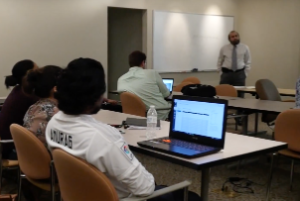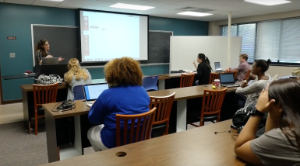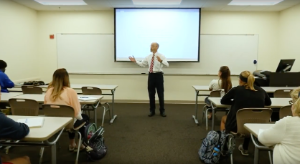Self Assessment Of Teaching
Assessing your skills as an instructor can be very rewarding and at the same time terrifying. How is it rewarding? You become acutely aware of how you are perceived in the classroom. Why is it terrifying? The most effective way to conduct a personal assessment of your teaching is to watch a video of yourself teaching. Watching a video of yourself teaching will reveal many aspects of how you conduct yourself in the classroom. This isn’t to say that you are not a good teacher, rather that the act of watching and hearing yourself teach can be so revealing that it can become difficult to watch. This happens because we are generally hypercritical of ourselves.
Assess yourself anyway. It will transform you into becoming a better instructor and your students deserve the best version of you in the classroom.
How to video yourself in the classroom.
One of the easiest ways to record yourself in the classroom is to use a web-camera on a tripod using Panopto. If you do not have one or any of these items you may contact Anushka Boyd in Instructional Technologies at boyd2008@fit.edu.
Panopto is software which makes recording yourself very easy to do. Here is a link to a training class on how to use Panopto in the classroom.
Here are a few items to assess as you watch a recording of yourself teaching. For each of these items rate yourself from 1 - 10:
Communication
Voice (tone, quality, modulation, projection)
Are you speaking in a monotone fashion or is your voice animated? Does your voice carry to the back of the room or is your volume such that a microphone would help? Is your voice commanding? Are you portraying the information as an expert or does your voice lend doubt to your knowledge of the subject?
Speech (usage, enunciation, pronunciation)
Are you speaking clearly, enunciating each word? Are you pronouncing the words correctly? If you were your student would you understand what you are saying?
Eye Contact
Do you make eye contact with your students? Do you make enough eye contact with your students?

Classroom Atmosphere
Shows interest in students
Are you attentive to your students? How can you tell?
Accessible to students
Are you accessible to your students? Are you approachable? How can you tell?
Cognizant of student learning needs
Are you aware that you students understand what you are professing or are you just blazing along trying to cover the material?
Encourages students to ask question/offer comments
Are you open to questions or comments from students? Do you ask direct questions to students? Do you encourage students to ask questions or is your way of questioning students a mere “Do you have any questions?” at the end of the class.
Responds to students’ questions and comments
Are you responsive to questions by students? Are students making comments that you do not address?
Student participation
Are students engaged or disengaged in your class? Are they on their cell phones? Are they sleeping or in conversation with their neighbor while you are teaching?
Accepts student contributions
Are you receptive to students' contributions in class? How can you tell?

Instructional Strategy/Activities
Start and end of class
Do you start promptly, or do you start late? Do you use the full class time?
State of preparedness
Are you ready for class? Did you plan your lesson?
Continuity of lesson to previous and/or future topics
Does your lesson connect to what was previously taught or will be taught? Do you students know how it connects?
Presentation of lesson
Is your presentation structured or more lackadaisical?
Images used
Do the images you chose to display relevant to the lesson?
Use of instructional tools/aids
How effective are the instructional tools/aids that you use during your lesson?
Questioning strategy
Do you ask open ended questions that ask for expansive answers or closed-ended questions which require a single fact or yes or no answers?

Content / Professional Proficiency
Subject matter knowledge
Is your subject matter knowledge shallow or deep?
Models instruction to promote student understanding
Is your instructional approach modeled to promote student understanding? Is your instruction chunked into portions that facilitate student understanding or are you offering up very large pieces of information for the sake of time?
Explains concepts to facilitate student understanding
Do you explain concepts clearly to your students? How can you tell?
Links new concepts to students’ prior knowledge
Are you giving students a way to relate new concepts to previously understood content? If you use arbitrary examples for simplicity’s sake are you using well-conceived ones?
by Jared Campbell

 Give to Florida Tech
Give to Florida Tech 